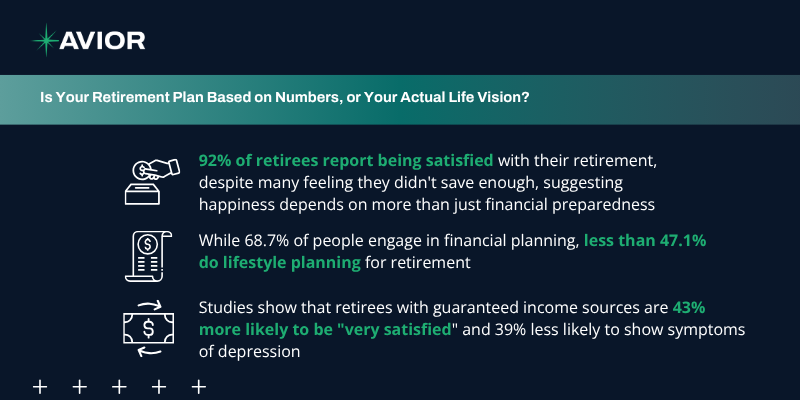Is Your Retirement Plan Based on Numbers, or Your Actual Life Vision?

When most people think about retirement planning, they start with a calculator. How much do I need to save? What’s my magic number? Will $1 million be enough? But recent research indicates that 92% of retirees report being satisfied with their retirement, even though many worry they didn’t save enough. This suggests that happiness in retirement might have less to do with hitting a specific dollar amount and more to do with something else entirely.
The truth is, retirement isn’t a math problem – it’s a life transition. While 68.7% of people do some financial planning for retirement, less than half engage in lifestyle planning. This gap between numbers-focused planning and vision-based planning might explain why some retirees with adequate savings still feel lost, while others with modest means find deep satisfaction in their golden years. The question isn’t just whether you can afford to retire, but whether you’re retiring to something meaningful.
Key Takeaways
- 92% of retirees report being satisfied with their retirement, despite many feeling they didn’t save enough, suggesting happiness depends on more than just financial preparedness
- While 68.7% of people engage in financial planning, less than 47.1% do lifestyle planning for retirement
- Studies show that retirees with guaranteed income sources are 43% more likely to be “very satisfied” and 39% less likely to show symptoms of depression
- More than 80% of retirees say health is the most important ingredient for a happy retirement, ranking it even above financial security
- People who are “much happier” in retirement are more likely to have paid off debt early, maintained their health, and cultivated social connections
- A clear retirement vision helps guide financial decisions and creates motivation that pure numbers alone cannot provide
The Problem with Numbers-Only Planning
Traditional retirement planning starts with a question: “How much money do I need?” Financial advisors run calculations based on your current income, desired replacement ratio, and life expectancy. You might hear that you need 10-12 times your annual income saved, or that you should aim to replace 70-80% of your pre-retirement income.
Why the Magic Number Approach Falls Short
These calculations assume retirement is simply an extension of your working life, just without the paycheck. But retirement represents a fundamental shift in how you spend your time, energy, and yes, your money. Without understanding what you actually want to do in retirement, any financial target is essentially a guess.
Consider two retirees with identical $1 million nest eggs. One dreams of traveling the world and maintaining an active social life, while the other prefers quiet hobbies at home and simple pleasures. Their financial needs – and their satisfaction levels – will be completely different, despite having the same “magic number.”
The numbers-only approach can also lead to two common mistakes: either undershooting because you haven’t thought deeply about your desired lifestyle, or overshooting and working longer than necessary because you’re afraid of not having “enough.”
The Gap Between Financial Security and Life Satisfaction
Research reveals a weak correlation between older Americans’ financial circumstances and retirement satisfaction. You can be financially prepared and still feel unprepared for the reality of retirement. Conversely, people with modest savings but clear purpose and strong relationships often report high satisfaction levels.
This disconnect happens because money is just a tool. Like any tool, its value depends entirely on what you’re trying to build. Without a vision of your ideal retirement lifestyle, even substantial savings can feel inadequate.
What Vision-Based Planning Looks Like
Vision-based retirement planning flips the traditional approach. Instead of starting with numbers, you start with life. What do you want your days to look like? How do you want to spend your time? What gives your life meaning beyond work?
Creating Your Retirement Vision
Start by imagining a typical week in retirement, five years from now. Be specific: Where are you living? What are you doing each day? Who are you spending time with? What activities bring you joy and fulfillment?
More than half of those nearing retirement hope to spend more time with loved ones, while 45% plan to travel more, and about one-third look forward to pursuing new hobbies. But your vision should be personal and detailed, not based on what others want.
Consider these key areas when developing your vision: your living situation, daily routines, relationships and social connections, health and wellness activities, learning and personal growth opportunities, and ways to contribute or give back.
Lifestyle Goals That Matter
Your retirement vision should address both the activities you want to pursue and the person you want to become. Many successful retirees set goals around personal growth – learning new skills, challenging themselves intellectually, or exploring creative pursuits.
Recent studies suggest that engaging in cognitively demanding, novel activities in older adulthood can enhance brain and memory function more than social activities alone. This means pursuing challenging hobbies or learning opportunities isn’t just enjoyable – it’s also beneficial for long-term mental health.
The social component of your vision is equally important. Work often provides our primary social network, so retirement requires intentional effort to maintain and build relationships. Consider how you’ll stay connected to friends, family, and community.
How Vision Shapes Your Financial Plan
Once you have a clear picture of your ideal retirement, the financial planning becomes much more focused and meaningful. Your vision provides the context that makes the numbers relevant.
Budgeting Based on Lifestyle
Instead of using generic replacement ratios, you can create a budget based on your actual planned activities. Want to travel extensively? Budget for transportation, accommodations, and experiences. Prefer to stay local but pursue expensive hobbies? Allocate funds accordingly.
This approach often reveals that you might need less money in some areas and more in others than generic calculations suggest. Many retirees find their housing costs decrease if they downsize or relocate, while their healthcare and leisure costs might increase.
Your vision also helps you prioritize. If maintaining your health is crucial to your retirement happiness – as it is for over 80% of retirees – you’ll want to budget adequately for healthcare, fitness activities, and preventive care.
Timeline and Sequence Planning
A clear vision helps you think about retirement in phases rather than as a single event. Early retirement might focus on active pursuits and travel, while later years might emphasize comfort, convenience, and healthcare access.
Understanding these phases helps you plan both financially and logistically. You might need more liquid savings for early retirement adventures but should also consider long-term care insurance for later needs.
Some people envision a gradual transition rather than full retirement, perhaps working part-time or starting a passion project. This vision affects both your savings timeline and your income replacement needs.
The Role of Purpose and Meaning
One of the biggest challenges in retirement isn’t financial – it’s finding purpose and meaning when work no longer provides structure and identity. People who thrive in retirement often have a clear sense of what gives their life meaning beyond their career.
Beyond the Paycheck
Work provides more than income. It offers identity, social connections, routine, and a sense of contribution. Successful retirement planning addresses how you’ll replace these non-financial benefits.
Some retirees find purpose in volunteer work, allowing them to contribute their skills and experience to causes they care about. Others pursue entrepreneurial ventures, start consulting practices, or engage in creative projects they never had time for during their careers.
The key is identifying what work provided for you beyond the paycheck and intentionally creating ways to meet those needs in retirement.
Health as Foundation
Studies consistently show that health is the most important factor for retirement happiness, ranking even above financial security. This makes sense – all the money in the world can’t buy happiness if you’re too unwell to enjoy it.
Vision-based planning recognizes this by making health and wellness central to retirement preparation. This includes not just healthcare planning and insurance, but also lifestyle choices that support long-term physical and mental health.
Regular exercise, social engagement, stress management, and preventive healthcare become investments in your retirement happiness, not just your retirement health.
Integrating Vision and Numbers
The most effective retirement planning integrates both vision and financial strategy. Your vision provides direction and motivation, while sound financial planning provides the resources to make that vision reality.
Making Numbers Meaningful
When your financial goals connect to a clear vision of your ideal life, saving becomes more motivated and intentional. Instead of saving toward an abstract number, you’re saving toward specific dreams and goals.
This connection also helps with financial decision-making throughout retirement. When faced with spending choices, you can evaluate them against your vision rather than arbitrary budget categories.
For example, if maintaining social connections is central to your retirement vision, spending money on travel to visit family or hosting gatherings becomes a clear priority, while other expenses might be less important.
Flexibility and Adaptation
Both your vision and your financial situation will evolve over time. Regular reviews help ensure they stay aligned. Major life changes – health issues, family circumstances, economic conditions – might require adjustments to both your lifestyle plans and financial strategy.
The advantage of vision-based planning is that it provides a framework for making these adjustments thoughtfully rather than reactively. When you’re clear about what matters most to you, you can adapt your plans while staying true to your core values and priorities.
Work With Us
Creating a retirement plan based on your actual life vision rather than generic calculations requires a different approach to financial planning. It means starting with the question “What kind of life do I want to live?” before asking “How much money do I need?” This vision-based approach often leads to both greater satisfaction in retirement and more effective financial strategies, because your money works toward goals that truly matter to you rather than arbitrary numerical targets.At Avior, we believe that the best retirement plans are built around your unique vision for the future, not one-size-fits-all formulas. We work with you to first clarify what you want your retirement to look like, then develop comprehensive financial strategies to support that vision. We help you think through all aspects of retirement planning – from healthcare and housing to hobbies and legacy goals – ensuring your financial plan serves your life goals rather than the other way around. Ready to build a retirement plan that reflects your actual dreams and aspirations? Contact Avior today to start planning not just for retirement, but for the life you want to live in retirement.
No Comments
Sorry, the comment form is closed at this time.




